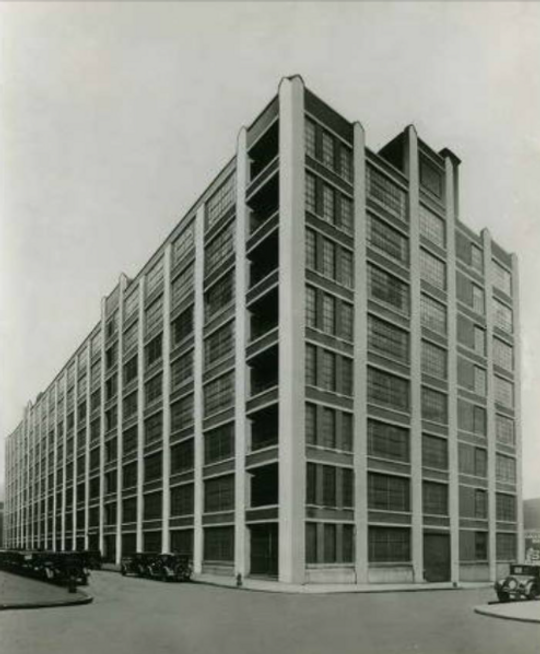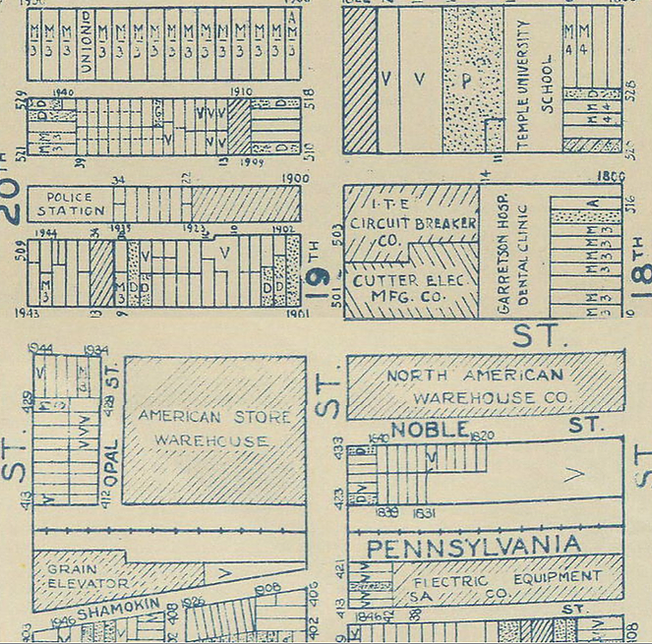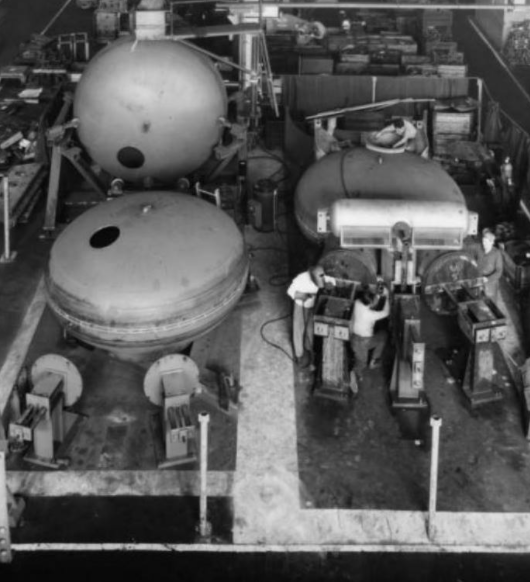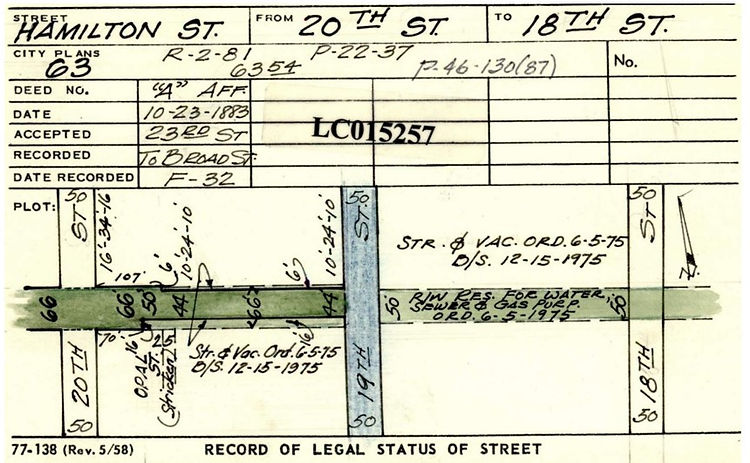Since 1835 there have been three dominant employers in our neighborhood. Baldwin Locomotive Works (BLW) employed up to 18,000 during its peak years. It moved completely by 1928. The Community College of Philadelphia (CCP) currently employs 1,200 and has been here as a full campus since 1983. In between the departure of BLW and the arrival of CCP, the dominant employer was I-T-E Circuit Breaker Company, with close to 4,000 employees, most of whom worked on the site that is now Baldwin Park.
The 20th century saw the age of light industry in our neighborhood, including the manufacture of electrical components. Our history articles include one on the transformer plant at 18th and Callowhill; the International Brotherhood of Electrical Workers (IBEW) on Spring Garden Street; and even a mention of the Electrical Switchgear Union at 1836-1838 Callowhill Street. This article will discuss the biggest of them all.

An I-T-E circuit breaker made by Cutter as seen in a 1902 catalog on the left.
On the right is a modern circuit breaker made by Siemens, which owns and uses the I-T-E trademark on low-voltage equipment.
Circuit breakers prevent overheating of wires and fires. For more see outside link here with a 58-page explainer from Cutter in 1909.
In 1888, one Henry Cutter began making circuit breakers in a private residence at 27 South 11th Street. Older glass-enclosed fuses contain a strip of metal that melts and breaks the circuit, protecting against electrical fires when the current is too high for that circuit. After each fuse burnout, the fuse would have to be replaced. Cutter made mechanical circuit breakers to supersede the fuse. A current surge would mechanically pop a knife switch which opened the circuit. To "replace" the circuit breaker (after checking the reason for the trip) only a flick of the switch was necessary. In 1928 his company changed its name to I-T-E Circuit Breaker Company, derived from the term "inverse time element," which describes the mechanism of action in that the higher the current surge, the shorter the time interval to break the circuit. These types of mechanical circuit breakers, with smaller components, are in use today. For a witty I-T-E marketing booklet from 1915, see here.
He moved westward to 1112 Sansom Street, then after he retired in 1891, the company moved to the northeast corner of 19th and Hamilton Streets. By 1946, a portion of the building at the future Tivoli site was being used by the I-T-E Circuit Breaker Company for administrative functions. I-T-E had taken over the former Baldwin Locomotive Works plant that was on the south side of the 1800 block of Hamilton and all the accessory buildings in the 1940s. In 1969 I-T-E Circuit Breaker merged with Eastman Imperial of Chicago to become I-T-E Imperial Company.

Photo from the 1920's of the Baldwin plant that was built in 1916 as a munitions factory. It would become a homeless shelter in 1931, then a warehouse, then the I-T-E factory.
The corner in the foreground is the northwest corner of the plant, making this view southeasterly looking at 19th and Hamilton Streets, right where the Baldwin Locomotive Works State historical plaque is located today.

Aerial photo from the southwest in 1928 showing the water tanks with BALDWIN painted on them atop the future I-T-E building. 1928 was the year that Baldwin Locomotive Works had completely moved to Eddystone.
Impressive resolution on this 1928 photo from a moving plane or zeppelin!

Portion of a map from 1922 showing automobiles and electricity replacing shoes and trimmings, as discussed in our article on the Graham and Laird factories. Baldwin Locomotive Works will be completely relocated to Eddystone by 1926.
.png)
Composite image of two sections of the 1942 land use map.

Aerial photo of the future Baldwin Park site around the same time as the above map. A few houses remain in the southern half of the future park and the future I-T-E eight-story building dominates the northern half. The Spring Garden Library is in the upper right next to the Mint Building. The Lit Brothers warehouse is the bright white building on the right. It was finished in 1941.
In our neighborhood I-T-E began buying up real estate in earnest in the 1940s. All of the buildings that were in the current Baldwin Park; the buildings that occupied the site where now stands the Tivoli; The Temple University satellite campus extending from Hamilton Street north to Spring Garden Street (the former Garretson Hospital, Hospital of Oral Surgery, and the Greatheart Maternity Hospital as discussed here); homes along the west side of Opal Street (what is now the north-south driveway on the west side of Tivoli); homes along 19th and 20th Streets; and homes along Ralston Street, Buttonwood Street, and Nectarine Street in the complex now known as Hamilton Townhomes. Once all the structures bordering certain streets were in possession of I-T-E, the following streets were formally vacated and stricken from the City Plan at the request of I-T-E: Pennsylvania Avenue between 18th and 19th Streets in 1955 (what is now on the south side of the park behind the fence, as discussed here); Opal Street between Pennsylvania Avenue and Hamilton Street in 1954; Noble Street which ran from 18th to 19th Street, bisecting the current Baldwin Park, in 1949; and Ralston Street between 19th and 20th Streets in 1964 (current site of Hamilton Townhomes). Cleveland Street, discussed in our article here, was a street that was newly created in 1978 as part of the Franklin Town development.
These sites would be cleared for development by 1971 when the Franklin Town Development was announced to the public. Many would remain as surface parking lots for decades.

Photo from 1946 of the southeast corner of Hamilton and 19th Streets.
The embossed name of the I-T-E Circuit Breaker Company has replaced the Baldwin signs.
Photo courtesy of the Free Library of Philadelphia.

Photo taken in 1946 looking northeast towards what is now Baldwin Park. from the corner of 19th and Pennsylvania Avenue. The eight-story I-T-E building, the former Baldwin shop, dominates what is now the northern half of the park. A coal yard and other I-T-E buildings occupy the southern half. In the left foreground is 19th Street with its trolley tracks.
The Franklin Town project would demolish everything in this view.
Photo courtesy of the Free Library of Philadelphia.

I-T-E main plant in 1947. Hamilton Street is on the left and 19th Street is on the right.
You are what your water tower says you are. The original BALDWIN label was replaced by the Acme market ASCO logo and in 1947 by the I-T-E logo.

Part of a Sanborn insurance map from 1951 (volume 4 plate 306).
I-T-E Circuit Breaker has taken over most of the future Tivoli site, and will eventually take over all of it. In this image the west side of Opal Street has been cleared of homes except for those fronting Hamilton Street and number 428.

The southeast corner of Hamilton and Opal Streets in 1945 shows the “J” and “K” buildings of I-T-E. The U-shaped building with a central courtyard presages the U-shaped Tivoli Condominiums built in 2006.

Photo within the courtyard of I-T-E during a celebration of winning the vote to unionize within the Electrical Switchgear Union. Union representation began in 1940.
This view would now be inside the Tivoli Condos courtyard.

Photo from the Inquirer of 26 July 1954 showing employees working on a low voltage switchboard.

Photo circa 1960 of the I-T-E facility at its peak in the neighborhood. The Lit Brothers warehouse is at the top left of the photo; otherwise, all the buildings are owned by I-T-E.

Composite image of two sections of the 1962 land use map.
Baldwin Park in 2021 occupies the two acres that in 1962 were occupied by the U.S. of A. I-T-E Circuit Breaker Company. The Electric Equipment Company in the lower right made transformers, as discussed here.

In 1967 I-T-E had changed its name via merger to I-T-E Imperial and was headquartered at the current site of the Tivoli at the southwest corner of 19th and Hamilton Streets.

You too can get rid of a Philadelphia street:
Once someone owns both sides of a street, that person or business can petition to have the street stricken from the city maps. This happened in 1975 with Opal Street on the west side of I-T-E (now Tivoli) site and with Hamilton Street running along the north edge of what is now Baldwin Park. You can explore other street histories here.
I-T-E owned a good amount of real estate in the neighborhood by 1971, and was one of the five partners in the Franklin Town Development Corporation, as discussed here. By this time I-T-E focused on distribution, transmission, and control of electricity, and manufactured hydraulics and fluid power systems. In 1976 I-T-E Imperial Corporation was acquired by Gould, Inc., and all of the I-T-E real estate was levelled between 1975 and 1985 for the Franklin Town Development project.
There were many acquisitions and mergers throughout the history of I-T-E, with a 1988 summary here . There is also a more neighborhood-focused summary as a postscript to this article. I-T-E is now mostly a part of Asea Brown Boveri.

Real estate holdings of I-T-E in 1971.
For a more granular, house-by-house, description of I-T-E holdings in the neighborhood see 80-page Park Trust Agreement of 1991 here
Postscript
I-T-E timeline with neighborhood events in bold font:
1888: Henry B. Cutter, living at 24 N 10th Street in Philadelphia, founds the Cutter Electrical Manufacturing Company on Chestnut Street. Two years later he develops the first circuit breakers utilizing his inverse time element concept.
1891: Cutter incorporates and moves to 27 S 11th Street.
1896: The business moves to 1112 Sansom Street.
1900: Two employees, William M. Scott and A. Edward Norton, purchase the business from Cutter. The Cutter company moves to larger space at the northeast corner of 19th and Hamilton Streets
1912: The Cutter Company acquires Walker Electric and its switchboard business.
1917: Cutter Company begins a long relationship with the United States military when it produces the first shock-hardened circuit breaker for the US Navy.
1928: the company name is changed to I-T-E Circuit Breaker Company to take advantage of the inverse time element technology in marketing.
1936: acquires Automatic Reclosing Circuit Breaker Company from Nash-Kelvinator.
1940: The Electrical Switchgear Union (ESU) begins representing the 3,500 employees at I-T-E. As discussed here, ESU moved from 17th and Brandywine to 1836-1838 Callowhill Street in 1854 (now the Kite and Key Pub) after purchasing the buildings from Emory Air Freight Company for $30,000. ESU also purchased the empty lot at 1840 Callowhill Street for $2,500 (now the outdoor patio for the Kite and Key).
April, 1941: I-T-E buys the American Stores warehouse at 1900 Hamilton Street (now the site of the Tivoli Condos).
1943: I-T-E receives the first of two “E for Excellence” awards from the federal government. Only 5% of all companies doing business with the government during the war would earn this award for efficiency and quality.
1945: A busy war effort is winding down. 1,236 I-T-E employees served in World War II, and 20 lost their lives.
1968: I-T-E Circuit Breaker Company merges with Imperial Eastman Company to become I-T-E Imperial Corporation. The company announces that 600 of the 3,900 employees at 19th and Hamilton Street will be relocated to a new facility in Bucks County, Pennsylvania, 37 miles north of the main plant at 19th and Hamilton. I-T-E is the largest land-owning partner in the Franklin Town Development Corporation, with plans to be announced in 1971.
1969: ESU votes to affiliate with the United Auto Workers Union (UAW). Maps of the neighborhood will mark 1836-1838 Callowhill Street as UAW.
1974: The small air circuit breaker division leaves 19th and Hamilton for Erie Avenue in Philadelphia.
1976: Gould Inc. acquires I-T-E Imperial and moves corporate headquarters to Chicago.
1979: Gould agrees to merge parts of its company with Brown Boveri & Company Ltd.
1980: The Navy breaker unit at 19th and Hamilton moves to Horsham, Pennsylvania. I-T-E’s presence in the neighborhood vanishes after eight decades.
1980 and on: mergers, acquisitions, and spin offs yield several name changes, including Siemans and Systems Protection Division
published July 2024


